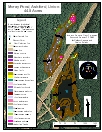Morey Pond, Ashford
2005 Aquatic Plant Survey Map of Morey Pond
Morey Pond is a body of water divided in two by I-84. The northern section is 16 acres and the southern section is 29 acres. There is no residential development along the shoreline. The Nipmuck State Forest and the highway surround the north basin and highways and woodland and agricultural land surround the south basin. There is a boat launch on the northern shore of the north basin. Access from one basin to another is via a small navigable culvert. The pond has a maximum depth of 11 feet (3.5 m) and a mean depth of 6.7 feet (2 m).
Our vegetation survey in August 2005 revealed a sedge to be the most widespread plant. The sedge was mostly found in the north basin where it covered the bottom throughout this area. White water lily (Nymphaea odorata) and purple bladderwort (Utricularia purpurea) also were abundant in the north basin. White water lily was the dominant species in two coves, one in the north and other on the west side, and also occurred in a small patch on the west side. Purple bladderwort was found on all sides of the north basin and as large scattered patches in the middle of the north basin. To a lesser extent, sevenangle pipewort (Eriocaulon aquaticum), snailseed pondweed (Potamogeton bicupulatus), floating-leaf pondweed (Potamogeton natans), and bur-reed (Sparganium species) also were found on all sides of the north basin.
Other species were not found on every side of the north basin and occurred in much smaller patches. Common bladderwort (Utricularia macrorhiza) was found in the middle and on the north, south, and west sides of the north basin. Brown-Fruited rush (Juncus pelocarpus) and humped bladderwort (Utricularia gibba) were found on the west and east sides, and floating bladderwort (Utricularia radiata) was found on the north and east sides of the north basin. Watershield (Brasenia schreberi), yellow water lily (Nuphar variegata), and marsh mermaid weed (Proserpinaca palustris) were found only on the north side, and charaphyte was only found on the south side of the north basin. Western waterweed (Elodea nuttallii) and slender naiad (Najas flexilis) were only found on the west side, and golden hedge-hyssop (Gratiola aurea) was only found on the east side of the north basin.
Vegetation in the south basin was limited to the shoreline at depths less than 6 feet (2 m). Needle spikerush (Eleocharis acicularis) was the most abundant species in the south basin, occurring on all sides. Sevenangle pipewort, snailseed pondweed, low watermilfoil (Myriophyllum humile), golden hedge-hyssop, ribbon-leaf pondweed (Potamogeton epihydrus), and purple bladderwort also occurred on all sides of the south basin.
Other species were not found on every side of the south basin. Bur-Reed occurred on the north, west and east sides of the basin. Floating bladderwort was found on the north and south sides, and brown-fruited rush and common bladderwort were found on the north and west sides of the basin. Charaphyte was found on the west and east sides of the south basin. Yellow water lily only occurred on the north side of the basin. Small waterwort (Elatine minima), humped bladderwort, and a sedge were found only on the west side, while spiney-spored quillwort (Isoëtes echinospora) and small pondweed (Potamogeton pusillus) were only found on the east side of the south basin.


